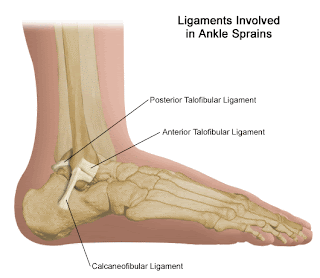The ankle joint is formed where the foot and the leg meet. The ankle, or talocrural joint, is a synovial hinge joint that connects the distal ends of the tibia and fibula in the lower limb with the proximal end of the talus bone in the foot. The articulation between the tibia and the talus bears more weight than between the smaller fibula and the talus.
The term ankle is used to describe structures in the region of the ankle joint proper.
Name derivation
The word ankle or ancle is common, in various forms, to Germanic languages, probably connected in origin with the Latin "angulus", or Greek "αγκυλος", meaning bent.
Anatomy
Bones
The boney architecture of the ankle consists of three bones: the tibia, the fibula, and the talus. The articular surface of the tibia is referred to as the plafond. The medial malleolus is a boney process extending distally off the medial tibia. The distal-most aspect of the fibula is called the lateral malleolus.
Together, the malleoli, along with their supporting ligaments, stabilize the talus underneath the tibia. The boney arch formed by the tibial plafond and the two malleoli is referred to as the ankle "mortise." The joint surface of all bones in the ankle are covered with articular cartilage.
Disorders
Fractures
Ankle fracture
Symptoms of an ankle fracture can be similar to those of ankle sprains (pain), though typically they are often more severe by comparison. It is exceedingly rare for the ankle joint to dislocate in the presence of ligamentous injury alone.
The talus is most commonly fractured by two methods. The first is hyperdorsiflexion, where the neck of the talus is forced against the tibia and fractures. The second is jumping from a height - the body is fractured as the talus transmits the force from the foot to the lower limb bones.
In the setting of an ankle fracture the talus can become unstable and subluxate or dislocate.
People may complain of ecchymosis (bruising), or there may be an abnormal position, abnormal motion, or lack of motion. Diagnosis is typically by X-ray. Treatment is either via surgery or casting depending on the fracture types.
 |
| Fractured Ankle |
How to stop ankle injuries


.jpg)


.jpg)



























0 comments